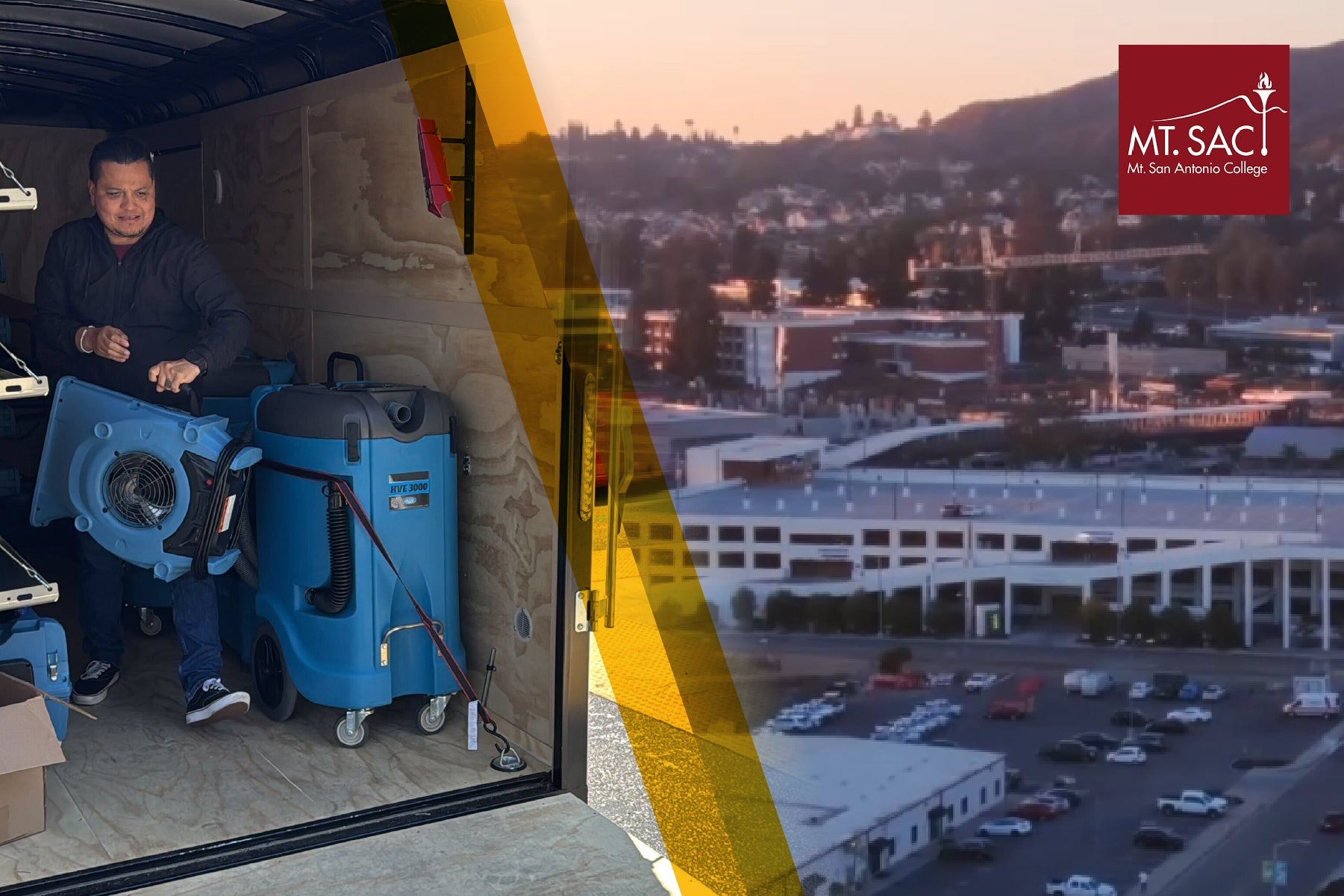When a burst pipe caused major flooding across Mt. San Antonio College’s (Mt. SAC’s) 400-acre campus in Walnut, CA, in 2022, the costs and disruptions added up as fast as the water spread.
Five of the college’s 51 buildings were damaged, including offices, classrooms, a STEM lab with nursing simulators, and server rooms. Water rose as high as 18 inches up walls, forcing the shutdown of two buildings and the relocation of entire programs to portable classrooms. The emergency remediation bill topped $200,000 for just the first two days – with the entire project costing nearly $3 million and taking two years to complete.
The Challenge
The 2022 incident revealed a critical gap in Mt. SAC’s emergency preparedness. Without in-house equipment or training, the college had no choice but to rely on external vendors, a dependency that resulted in delayed response times, high costs, and extended disruptions.
Beyond the financial hit, the logistics of displacing entire programs were daunting. Portable classrooms had to be rented and outfitted with AV systems, projectors, and internet. Students lost access to specialized spaces like science and computer labs, while faculty and staff endured months of upheaval.
Duetta Wasson, Director of Safety and Risk Management, said that the incident forced the college to reevaluate. “We looked at the cost of the claim versus the cost of the Ready 2 Respond program, and it was a no-brainer,” she said. “Having our own system and staff trained would allow us to mitigate water loss even faster – a win-win situation.”
Mt. SAC’s risk management team set a clear goal: build the capacity to respond faster, reduce reliance on contractors, and protect the campus from repeat disruptions.
The R2R Solution
Working with the Ready 2 Respond® (R2R) team, Mt. SAC invested in a mobile water damage response trailer equipped with three complete kits of professional-grade drying equipment, including extractors, dehumidifiers, and airmovers.
Facilities staff also completed R2R® First Responder Training, earning certification and hands-on experience in proper mitigation and drying techniques. The training provided more than just technical skills – it gave the staff a comprehensive understanding of water damage remediation, reinforcing their role as essential first responders on campus.
“Training meant a lot to the staff. Now the team has a much more comprehensive idea of what water damage remediation should look like,” Wasson said.
Creative Funding Approach
Like many institutions, Mt. SAC faced budget constraints. Initially, there was no dedicated account to invest in the equipment required for in-house water event response. However, leadership found a way by tapping into insurance dividends and reallocating it for the R2R program.
This creative funding approach transformed a financial obstacle into an opportunity, establishing both the purchase of the mobile unit and an ongoing emergency preparedness budget line item.
The Results
The return on investment was immediate. Just one week after completing R2R training, Mt. SAC experienced another water loss. This time, instead of waiting for a vendor, the trained facilities team deployed their new equipment and handled the incident themselves. The estimated savings for that event alone was $70,000 – more than enough to cover the initial program investment.
Since then, the college has deployed the full R2R system at least three times for major incidents, including pipe failures and storm-related water intrusions, and has used the equipment regularly for more minor issues, such as drying carpets or mitigating small plumbing leaks.
Key outcomes include:
- Immediate ROI – $70K saved in the first week of implementation.
- Reduced downtime – faster response minimized disruption to classes, labs, and offices.
- Cultural shift – facilities staff gained confidence, pride, and recognition for their role.
- Sustainable program – emergency preparedness funding is now a regular budget item.
Confidence, Pride, and Culture Shift
For Mt. SAC, the impact extends beyond financial savings. Facilities staff are now recognized across campus as critical first responders, equipped with the skills and tools to manage emergencies directly. This recognition has fostered a stronger sense of pride and reinforced the value of their work.
“It’s been positive in all realms,” Wasson said.
Looking Ahead
What began as a costly $3 million water loss became a turning point for Mt. San Antonio College. By investing in training and equipment, and using a creative funding model, the college not only reduced risk but also empowered its facilities team to safeguard campus operations.
Today, Mt. SAC’s facilities staff aren’t just maintaining buildings; they are certified first responders who protect classrooms, labs, and offices while saving the institution significant costs. The result is a stronger, more resilient campus with a culture of preparedness that benefits the entire community.
Contact the R2R team for assistance with a customized response plan that includes tailored, hands-on training. For facility management tips, follow us on LinkedIn and subscribe to our monthly Facility Insights enewsletter.


Drying Equipment Placement: Common Mistakes to Avoid
Before the Freeze: Tips for Avoiding Winter Water Damage